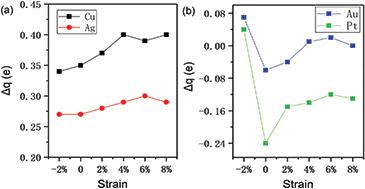当前位置:
X-MOL 学术
›
J. Mater. Chem. C
›
论文详情
Our official English website, www.x-mol.net, welcomes your
feedback! (Note: you will need to create a separate account there.)
Substitutional doped GeSe: tunable oxidative states with strain engineering
Journal of Materials Chemistry C ( IF 5.7 ) Pub Date : 2020-09-07 , DOI: 10.1039/d0tc03272g Zheng Shu 1, 2, 3, 4, 5 , Yongqing Cai 3, 4, 5, 6, 7
Journal of Materials Chemistry C ( IF 5.7 ) Pub Date : 2020-09-07 , DOI: 10.1039/d0tc03272g Zheng Shu 1, 2, 3, 4, 5 , Yongqing Cai 3, 4, 5, 6, 7
Affiliation

|
Layered chalcogenide materials are a wealth of nanoelectronics applications, like resistive switching and energy-harvesting (such as photocatalysis), owing to its electronics, orbitals, and lattice excitations. In this work, we explore monochalcogenide germanium selenide GeSe with respect to substitutional doping with 13 metallic cations by first-principles calculations. Typical dopants, including s-shell (alkali elements Li and Na), p-shell (Al, Pb and Bi), 3d (Fe, Cu, Co and Ni), 4d (Pd and Ag) and 5d (Au and Pt) elements, are systematically examined. Amongst all cationic dopants, Al with highest oxidation states, implying a high mobility driven by the electric field, and Al-doped GeSe may be promising candidates for novel resistive switching devices. We show that many localized induced states exist in the band gap of GeSe on doping with Fe, Co, or Ni. In contrast, for the Cu, Ag, and Au, there is no such state in the gap. Ag and Cu have +0.27 and +0.35 charges respectively, and the positive charges are beneficial for the field-driven motion in GeSe. In contrast, Au is slightly negatively charged, which renders the Au-doped GeSe as a promising photocatalyst and enhanced surface plasmon. Moreover, we explore the coexistence of the dopant and strain in GeSe, and find dynamical adjustments of localized states in GeSe with levels successively shifting upward/downward with strain. This induces dynamic oxidative states of the dopants under strain, which should be quite popular in composites where the motion of metal adatoms causes significant deformation.
中文翻译:

取代掺杂的GeSe:应变工程可调节的氧化态
层状硫族化物材料由于其电子学,轨道和晶格激发而具有大量的纳米电子应用,例如电阻切换和能量收集(例如光催化)。在这项工作中,我们通过第一性原理计算,探讨了硫族元素硒化锗锗硒在13种金属阳离子的取代掺杂方面的作用。典型的掺杂剂,包括s壳(碱金属元素Li和Na),p壳(Al,Pb和Bi),3d(Fe,Cu,Co和Ni),4d(Pd和Ag)和5d(Au和Pt)元素,进行系统地检查。在所有阳离子掺杂剂中,具有最高氧化态的Al(暗示着由电场驱动的高迁移率)和Al掺杂的GeSe可能是新型电阻开关器件的有希望的候选者。我们表明,在掺入Fe,Co,或镍。相反,对于Cu,Ag和Au,间隙中没有这种状态。Ag和Cu分别具有+0.27和+0.35的电荷,正电荷有利于GeSe中的场驱动运动。相反,Au略带负电荷,这使得Au掺杂的GeSe成为有前途的光催化剂和增强的表面等离子体。此外,我们探索了GeSe中掺杂物和应变的共存,并发现了GeSe中局部态的动态调整,其水平随应变而不断向上/向下移动。这会在应变下引起掺杂剂的动态氧化态,这在金属吸附原子的运动会引起明显变形的复合材料中非常普遍。正电荷有利于GeSe中的场驱动运动。相反,Au略带负电荷,这使得Au掺杂的GeSe成为有前途的光催化剂和增强的表面等离子体。此外,我们探索了GeSe中掺杂物和应变的共存,并发现了GeSe中局部态的动态调整,其水平随应变而不断向上/向下移动。这会在应变下引起掺杂剂的动态氧化态,这在金属吸附原子的运动会引起明显变形的复合材料中非常普遍。正电荷有利于GeSe中的场驱动运动。相反,Au略带负电荷,这使得Au掺杂的GeSe成为有前途的光催化剂和增强的表面等离子体。此外,我们探索了GeSe中掺杂物和应变的共存,并发现了GeSe中局部态的动态调整,其水平随应变而不断向上/向下移动。这会在应变下引起掺杂剂的动态氧化态,这在金属吸附原子的运动会引起明显变形的复合材料中非常普遍。我们探索了GeSe中掺杂物和应变的共存,并发现了GeSe中局部态的动态调整,其水平随应变而不断向上/向下移动。这会在应变下引起掺杂剂的动态氧化态,这在金属吸附原子的运动会引起明显变形的复合材料中非常普遍。我们探索了GeSe中掺杂物和应变的共存,并发现了GeSe中局部态的动态调整,其水平随应变而不断向上/向下移动。这会在应变下引起掺杂剂的动态氧化态,这在金属吸附原子的运动会引起明显变形的复合材料中非常普遍。
更新日期:2020-10-16
中文翻译:

取代掺杂的GeSe:应变工程可调节的氧化态
层状硫族化物材料由于其电子学,轨道和晶格激发而具有大量的纳米电子应用,例如电阻切换和能量收集(例如光催化)。在这项工作中,我们通过第一性原理计算,探讨了硫族元素硒化锗锗硒在13种金属阳离子的取代掺杂方面的作用。典型的掺杂剂,包括s壳(碱金属元素Li和Na),p壳(Al,Pb和Bi),3d(Fe,Cu,Co和Ni),4d(Pd和Ag)和5d(Au和Pt)元素,进行系统地检查。在所有阳离子掺杂剂中,具有最高氧化态的Al(暗示着由电场驱动的高迁移率)和Al掺杂的GeSe可能是新型电阻开关器件的有希望的候选者。我们表明,在掺入Fe,Co,或镍。相反,对于Cu,Ag和Au,间隙中没有这种状态。Ag和Cu分别具有+0.27和+0.35的电荷,正电荷有利于GeSe中的场驱动运动。相反,Au略带负电荷,这使得Au掺杂的GeSe成为有前途的光催化剂和增强的表面等离子体。此外,我们探索了GeSe中掺杂物和应变的共存,并发现了GeSe中局部态的动态调整,其水平随应变而不断向上/向下移动。这会在应变下引起掺杂剂的动态氧化态,这在金属吸附原子的运动会引起明显变形的复合材料中非常普遍。正电荷有利于GeSe中的场驱动运动。相反,Au略带负电荷,这使得Au掺杂的GeSe成为有前途的光催化剂和增强的表面等离子体。此外,我们探索了GeSe中掺杂物和应变的共存,并发现了GeSe中局部态的动态调整,其水平随应变而不断向上/向下移动。这会在应变下引起掺杂剂的动态氧化态,这在金属吸附原子的运动会引起明显变形的复合材料中非常普遍。正电荷有利于GeSe中的场驱动运动。相反,Au略带负电荷,这使得Au掺杂的GeSe成为有前途的光催化剂和增强的表面等离子体。此外,我们探索了GeSe中掺杂物和应变的共存,并发现了GeSe中局部态的动态调整,其水平随应变而不断向上/向下移动。这会在应变下引起掺杂剂的动态氧化态,这在金属吸附原子的运动会引起明显变形的复合材料中非常普遍。我们探索了GeSe中掺杂物和应变的共存,并发现了GeSe中局部态的动态调整,其水平随应变而不断向上/向下移动。这会在应变下引起掺杂剂的动态氧化态,这在金属吸附原子的运动会引起明显变形的复合材料中非常普遍。我们探索了GeSe中掺杂物和应变的共存,并发现了GeSe中局部态的动态调整,其水平随应变而不断向上/向下移动。这会在应变下引起掺杂剂的动态氧化态,这在金属吸附原子的运动会引起明显变形的复合材料中非常普遍。











































 京公网安备 11010802027423号
京公网安备 11010802027423号